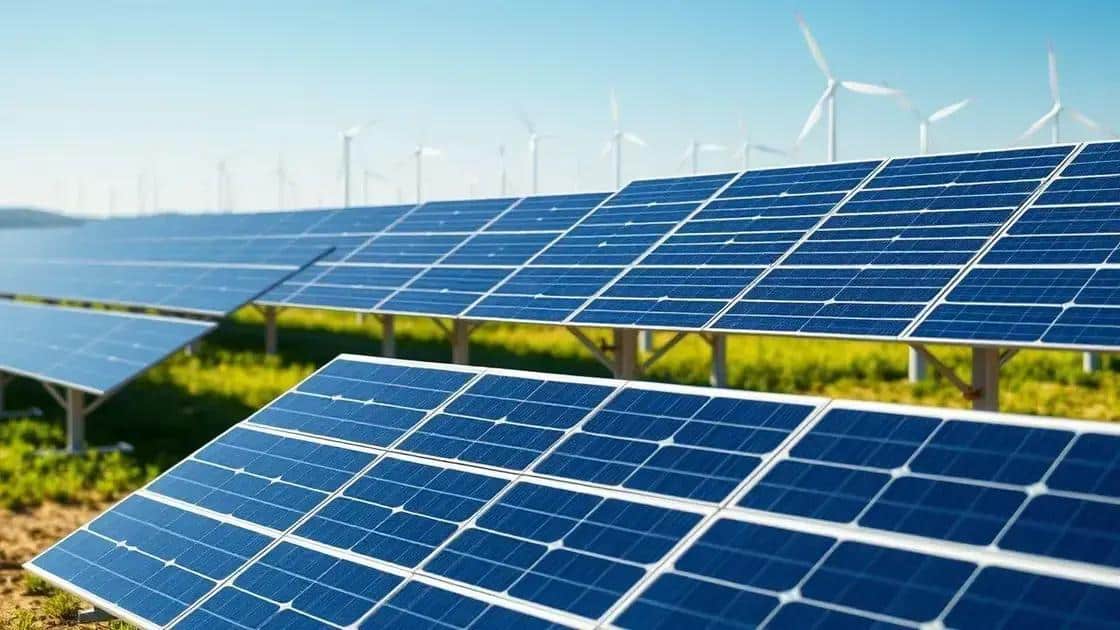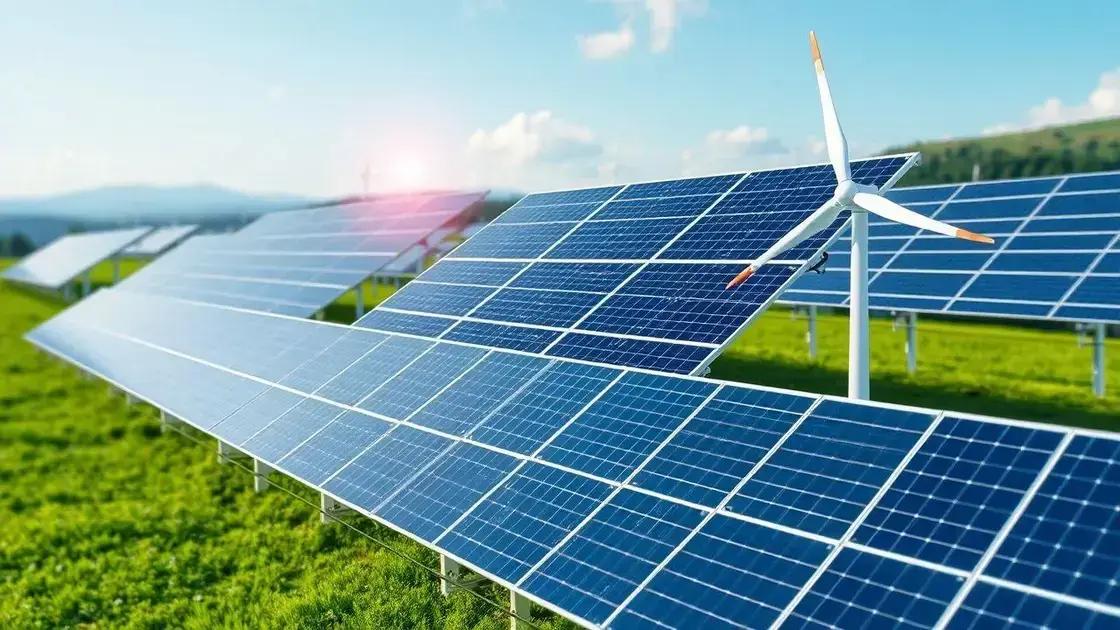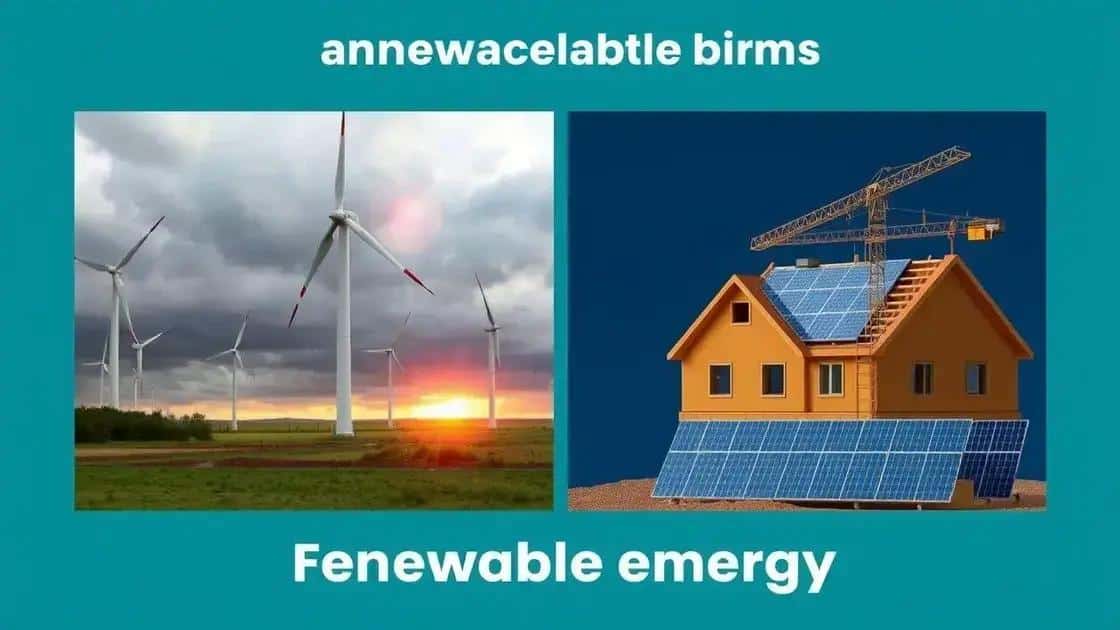Insights on renewable energy expansion and its benefits

Renewable energy expansion faces challenges such as intermittency of energy sources, high initial costs, public perception, and regulatory hurdles, but offers significant economic benefits and job creation opportunities.
Insights on renewable energy expansion show a rapidly changing landscape that affects us all. Have you ever wondered how these shifts contribute to a more sustainable future? Let’s dive into the details.
The current state of renewable energy
The current state of renewable energy is evolving rapidly, shaping our future in impactful ways. With new technologies emerging and global initiatives pushing for sustainable solutions, it’s essential to understand where we stand today. This shift not only addresses climate change but also opens up economic opportunities.
Global Adoption of Renewable Energy
Many countries are increasing their reliance on renewable sources. For example, solar and wind energy are leading the charge in the transition. The following are key facts on global adoption:
- Solar power capacity has grown significantly over the last decade.
- Wind energy is one of the fastest-growing energy sources worldwide.
- Countries like Germany and China are setting ambitious renewable energy goals.
As we observe this landscape, it’s vital to acknowledge the growing investments in these technologies. This trend is driven by a collective desire to reduce fossil fuel dependency, promoting sustainable practices that benefit both the environment and the economy. Each advancement in renewable technology serves as a stepping stone towards a greener future.
Renewable Energy Generation Methods
Many different methods generate renewable energy, each contributing uniquely to our energy mix. Here are some prominent types:
- Solar Energy: Harnessing energy from the sun, solar panels convert sunlight into electricity.
- Wind Energy: Wind turbines capture wind currents to produce power.
- Hydropower: Using flowing water, hydropower generates electricity through dams and rivers.
- Geothermal Energy: This method utilizes heat from the earth’s core to generate energy.
These methods are part of the concerted effort to reduce carbon emissions and promote renewable alternatives to fossil fuels. By diversifying our energy sources, we can enhance our energy security and mitigate climate risks.
As we look at the current state of renewable energy, it is evident that the momentum is strong. Public awareness is growing, as is the need for policy changes that support renewables. Innovative breakthroughs in technology are making these sources more reliable and efficient. As we move forward, it’s essential to stay informed and proactive about embracing this green revolution.
Technological advancements driving expansion

Technological advancements are fueling the expansion of renewable energy in remarkable ways. Every day, innovations are being introduced that make renewable sources more efficient, cost-effective, and accessible to users worldwide. This change is vital in our quest for a sustainable future.
Innovations in Solar Technology
One significant area of focus is solar technology. The development of new solar panel materials and designs is helping to capture more sunlight and convert it into electricity efficiently. Recent advancements include:
- Bifacial solar panels: These panels can capture light from both sides, increasing energy production.
- Thin-film solar cells: They are lighter and flexible, making them easier to install in various locations.
- Solar tracking systems: These systems move panels to follow the sun, maximizing exposure throughout the day.
These innovations not only improve efficiency but also lower the cost of solar energy, making it an attractive option for households and businesses alike. Enhancing the performance of solar technology is a key element in the broader adoption of renewable energy solutions.
Advancements in Wind Energy
Wind energy is also benefiting from significant technological upgrades. Turbines are becoming larger and more efficient, capturing wind energy even in low-wind conditions. Some critical advancements include:
- Smart turbine technology: These turbines use sensors and data analytics to optimize performance.
- Offshore wind farms: Expanding operations into oceans can harness stronger and more consistent winds.
- Advanced materials: Using lighter and more durable materials in turbine blades improves longevity and efficiency.
The shift towards larger wind farms and more powerful turbines means that we can produce more energy for less environmental impact. These advancements play a crucial role in meeting global energy demands while decreasing reliance on fossil fuels.
As these technologies evolve, our capacity to harness renewable energy expands. Advanced energy storage solutions, such as batteries, are also emerging. Improved battery technologies are enabling us to store excess energy generated during peak production hours and use it when needed, enhancing the overall reliability of renewable sources.
Every technological breakthrough helps to pave the way toward a future dominated by clean energy. As innovation continues to shape this landscape, it’s exciting to imagine the potential growth in the renewable sector.
Economic impacts of renewable energy growth
The economic impacts of renewable energy growth are far-reaching and transformative. As more countries invest in renewable resources, such as solar and wind energy, their economies benefit significantly. This shift not only mitigates climate change effects but also enhances energy independence.
Job Creation in Renewable Energy
One of the most notable effects is the increase in job opportunities. The growth of renewable energy sectors leads to the creation of many new jobs, including:
- Installation technicians: Skilled workers are needed to install solar panels and wind turbines.
- Maintenance specialists: These professionals ensure that renewable energy systems function properly.
- Research and development roles: Innovators are essential for advancing technology in the renewable field.
These roles contribute positively to local economies and provide stable career paths for many individuals. As the demand for clean energy rises, so does the need for a workforce skilled in green technologies.
Investment Opportunities
Moreover, renewable energy sectors attract significant investments. Investors see the potential for growth and profitability. Some key aspects include:
- Increased public and private investments: Funding is crucial for developing new technologies.
- Lower costs of clean energy: Advances in technology drive down prices, making investment more attractive.
- Government incentives: Tax credits and subsidies encourage more businesses to adopt renewable practices.
This influx of capital fosters innovation and facilitates the development of infrastructure that can support large-scale renewable projects. As a result, economic growth is stimulated across various sectors.
The impact on energy prices is another significant benefit. As renewable energy sources become more integral to energy production, reliance on unpredictable fossil fuels diminishes. This leads to more stable and often lower energy costs for consumers. Over time, as renewable technologies become mainstream, the long-term savings can be substantial.
Ultimately, the economic impacts of renewable energy growth indicate a bright future. By continuing to promote clean energy advancements, nations can achieve greater energy security and help protect the environment while reaping substantial economic benefits. This holistic approach not only empowers communities but also ensures a healthier planet for generations to come.
Challenges faced by renewable energy initiatives

Despite the progress made in renewable energy, various challenges hinder the growth of these initiatives. It is crucial to identify these obstacles to promote a more sustainable energy future. Understanding these challenges also helps policymakers develop effective strategies.
Intermittency of Energy Sources
One of the primary challenges is the intermittent nature of renewable energy sources. Solar and wind energies depend on weather conditions, which leads to fluctuating energy outputs. This inconsistency can cause:
- Supply issues: Energy may not be available when demand is high.
- Grid stability concerns: Integrating variable energy sources complicates grid management.
- Storage needs: Efficient energy storage solutions are required to balance supply and demand.
Focusing on improving battery technology and other storage methods is critical for overcoming these issues and ensuring a reliable energy supply from renewable sources.
High Initial Investment Costs
Another significant hurdle is the high initial investment required for renewable energy projects. Despite decreasing prices over time, upfront costs remain a barrier for many. Key factors include:
- Infrastructure development: Building solar farms or wind turbines requires substantial financial resources.
- Technology acquisition: Investing in the latest technologies may be costly but essential for efficiency.
- Financing challenges: Securing funding can be difficult, particularly for smaller projects.
Governments and investors play a pivotal role in addressing these costs through incentives, grants, and support for research and development.
In addition to financial barriers, public perception significantly influences the acceptance of renewable energy. Some communities may resist changes due to concerns about environmental impacts or land use. Engaging with local populations through education about the benefits of renewable energy can help mitigate these challenges.
Furthermore, regulatory frameworks can impede rapid expansion. Zoning laws, permitting processes, and other regulations need to be streamlined to facilitate quicker deployment of renewable energy projects. Establishing clear guidelines and reducing bureaucratic red tape can help accelerate the shift towards cleaner energy solutions.
Despite these challenges, the potential benefits of overcoming them are immense. By addressing the barriers faced by renewable energy initiatives, we can build a sustainable energy future that benefits both the environment and the economy.
FAQ – Frequently Asked Questions about Renewable Energy
What are the main challenges faced by renewable energy initiatives?
The main challenges include intermittency of energy supply, high initial costs, public perception, and regulatory hurdles.
How does renewable energy create jobs?
Renewable energy initiatives create jobs in areas like installation, maintenance, and research, contributing positively to local economies.
What advancements are being made in renewable energy technology?
Advancements include improvements in solar panel efficiency, larger wind turbines, and better energy storage solutions.
Why is public perception important for renewable energy projects?
Public acceptance can greatly influence the success and effectiveness of renewable energy initiatives, making community engagement crucial.





